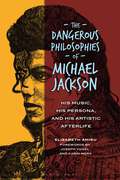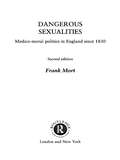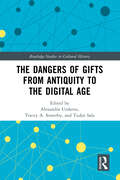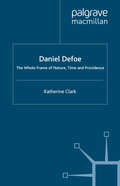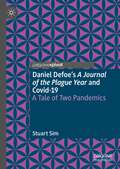- Table View
- List View
Dangerous Offenders: Punishment and Social Order
by Mark Brown John PrattThis highly controversial new book considers how the dangerous offender has become such a figure of collective anxiety for the citizens of rationalised Western societies. The authors consider:* ideas of danger and social threat in historical perspective* legal responses to violent criminals* attempts to predict dangerous behaviour* why particular groups, such as women, remain at risk from violent crime.This inspired collection invites us to rethink the received wisdom on dangerous offenders, and will be of interest to students and scholars in the fields of criminology and the sociology of Risk.
The Dangerous Philosophies of Michael Jackson: His Music, His Persona, and His Artistic Afterlife
by Elizabeth AmisuAn essential companion to Michael Jackson's music, films, and books, this work offers 21 original, academic essays on all things Jackson—from film, music, and dance to fashion, culture, and literature.Michael Jackson is regarded as one of the most important musicians of our time. Going well beyond the average celebrity biography, this comprehensive book looks at why that is true, offering insights into every facet of Jackson's art, life, and artistic afterlife. It looks at the methods by which his work was created, presented, received, and appropriated; discusses Jackson's varied personas along with his public and private appearances, albums, conceptual art, short films, and dance; and considers his use of costume, makeup, and reinvention. To help readers understand the phenomenon that was—and is—Michael Jackson, the book focuses on Jackson's historical context through an analysis of his films, songs, and books, examining him as an artist and shedding light on the political and ideological debates that surrounded him. Not shying away from the controversial aspects of Jackson's life and legacy, it also tackles questions of sexuality and racism, gender, and class, comparing Jackson to artists ranging from J. S. Bach to Andy Warhol. Through its examination of Jackson's entire catalog, the work connects all the aspects of his art and life to exemplify—and explain—the performer's unparalleled influence in the 20th and 21st centuries.
The Dangerous Philosophies of Michael Jackson: His Music, His Persona, and His Artistic Afterlife
by Elizabeth AmisuAn essential companion to Michael Jackson's music, films, and books, this work offers 21 original, academic essays on all things Jackson—from film, music, and dance to fashion, culture, and literature.Michael Jackson is regarded as one of the most important musicians of our time. Going well beyond the average celebrity biography, this comprehensive book looks at why that is true, offering insights into every facet of Jackson's art, life, and artistic afterlife. It looks at the methods by which his work was created, presented, received, and appropriated; discusses Jackson's varied personas along with his public and private appearances, albums, conceptual art, short films, and dance; and considers his use of costume, makeup, and reinvention. To help readers understand the phenomenon that was—and is—Michael Jackson, the book focuses on Jackson's historical context through an analysis of his films, songs, and books, examining him as an artist and shedding light on the political and ideological debates that surrounded him. Not shying away from the controversial aspects of Jackson's life and legacy, it also tackles questions of sexuality and racism, gender, and class, comparing Jackson to artists ranging from J. S. Bach to Andy Warhol. Through its examination of Jackson's entire catalog, the work connects all the aspects of his art and life to exemplify—and explain—the performer's unparalleled influence in the 20th and 21st centuries.
Dangerous Places: Health, Safety, and Archaeology
by David A. Poirier Kenneth L. FederArchaeological sites often seem to be idyllic, even romantic, places where scientists recover and analyze fascinating data that can inform us of past times and the past lives of our recent historical and ancient prehistoric human forebears. Too often, however, unrecognized dangers lie within: bacterial and viral infections hidden in the soil, concealed in the animals that roam through our sites, or even lying in wait in organic remains we excavate; toxic substances produced by the historical technologies we study and that continue to poison the sites where people once worked; the bodies of people who died of historical scourges that once afflicted humanity and whose excavated mortal remains may still harbor the pathogens that killed them, dormant and lying in wait for an unsuspecting and largely no-longer immune modern population. It's enough to make an archaeologist swear off fieldwork!The truth is, however, that archaeologists need to be alerted to the dangers present in fieldwork and advised of the reasonable precautions that should be taken to insure the safest possible working environment. Dangerous Places brings together an enormous body of information regarding the threats that archaeologists face every day, and the best ways of behaving proactively to avoid or mitigate these threats.
The Dangerous Sex: The Myth of Feminine Evil (Routledge Revivals)
by Hoffman R HaysFirst published in 1966, The Dangerous Sex shows how the irrational concept of the "dangerous sex" evolved and how it was – and is – used by man to maintain his dominance. He examines sexual practices and beliefs, marriage customs and rituals, and social behaviour in every society and every age from pre-historic times to the present day. The result is a revealing picture of the deep-seated male hostility that generates the way of the sexes and has fed it throughout human history. It is also a blazing indictment of this ingrained psycho-social pattern, as it unconsciously destroys and disrupts huge areas of human happiness. In this enquiry into misogyny, H. R. Hays suggests that men must face their own compulsions before a true and balanced relation between the sexes is achieved. This book therefore throws a new light on the problems of feminism, the feminine mystique and the whole controversy concerning the place of women in society, and will be of interest to students of literature, gender studies, anthropology and psychology.
The Dangerous Sex: The Myth of Feminine Evil (Routledge Revivals)
by Hoffman R HaysFirst published in 1966, The Dangerous Sex shows how the irrational concept of the "dangerous sex" evolved and how it was – and is – used by man to maintain his dominance. He examines sexual practices and beliefs, marriage customs and rituals, and social behaviour in every society and every age from pre-historic times to the present day. The result is a revealing picture of the deep-seated male hostility that generates the way of the sexes and has fed it throughout human history. It is also a blazing indictment of this ingrained psycho-social pattern, as it unconsciously destroys and disrupts huge areas of human happiness. In this enquiry into misogyny, H. R. Hays suggests that men must face their own compulsions before a true and balanced relation between the sexes is achieved. This book therefore throws a new light on the problems of feminism, the feminine mystique and the whole controversy concerning the place of women in society, and will be of interest to students of literature, gender studies, anthropology and psychology.
Dangerous Sex, Invisible Labor: Sex Work and the Law in India
by Prabha KotiswaranPopular representations of third-world sex workers as sex slaves and vectors of HIV have spawned abolitionist legal reforms that are harmful and ineffective, and public health initiatives that provide only marginal protection of sex workers' rights. In this book, Prabha Kotiswaran asks how we might understand sex workers' demands that they be treated as workers. She contemplates questions of redistribution through law within the sex industry by examining the political economies and legal ethnographies of two archetypical urban sex markets in India. Kotiswaran conducted in-depth fieldwork among sex workers in Sonagachi, Kolkata's largest red-light area, and Tirupati, a temple town in southern India. Providing new insights into the lives of these women--many of whom are demanding the respect and legal protection that other workers get--Kotiswaran builds a persuasive theoretical case for recognizing these women's sexual labor. Moving beyond standard feminist discourse on prostitution, she draws on a critical genealogy of materialist feminism for its sophisticated vocabulary of female reproductive and sexual labor, and uses a legal realist approach to show why criminalization cannot succeed amid the informal social networks and economic structures of sex markets. Based on this, Kotiswaran assesses the law's redistributive potential by analyzing the possible economic consequences of partial decriminalization, complete decriminalization, and legalization. She concludes with a theory of sex work from a postcolonial materialist feminist perspective.
Dangerous Sex, Invisible Labor: Sex Work and the Law in India (PDF)
by Prabha KotiswaranPopular representations of third-world sex workers as sex slaves and vectors of HIV have spawned abolitionist legal reforms that are harmful and ineffective, and public health initiatives that provide only marginal protection of sex workers' rights. In this book, Prabha Kotiswaran asks how we might understand sex workers' demands that they be treated as workers. She contemplates questions of redistribution through law within the sex industry by examining the political economies and legal ethnographies of two archetypical urban sex markets in India. Kotiswaran conducted in-depth fieldwork among sex workers in Sonagachi, Kolkata's largest red-light area, and Tirupati, a temple town in southern India. Providing new insights into the lives of these women--many of whom are demanding the respect and legal protection that other workers get--Kotiswaran builds a persuasive theoretical case for recognizing these women's sexual labor. Moving beyond standard feminist discourse on prostitution, she draws on a critical genealogy of materialist feminism for its sophisticated vocabulary of female reproductive and sexual labor, and uses a legal realist approach to show why criminalization cannot succeed amid the informal social networks and economic structures of sex markets. Based on this, Kotiswaran assesses the law's redistributive potential by analyzing the possible economic consequences of partial decriminalization, complete decriminalization, and legalization. She concludes with a theory of sex work from a postcolonial materialist feminist perspective.
Dangerous Sexualities: Medico-Moral Politics in England Since 1830
by Frank MortDangerous Sexualities takes a look at how our ideas of health and disease are linked to moral and immoral notions of sex. Beginning in the 1830s, Frank Mort relates his social historical narratives to the sexual choices and possibilities facing us now.This long-awaited second edition has been thoroughly updated to include new discussions of eugenics, race hygiene and social imperialism in the late nineteenth and early twentieth centuries. With a new and extended bibliography, introduction and illustrations, this second edition brings a classic into the 21st Century.
Dangerous Sexualities: Medico-Moral Politics in England Since 1830
by Frank MortDangerous Sexualities takes a look at how our ideas of health and disease are linked to moral and immoral notions of sex. Beginning in the 1830s, Frank Mort relates his social historical narratives to the sexual choices and possibilities facing us now.This long-awaited second edition has been thoroughly updated to include new discussions of eugenics, race hygiene and social imperialism in the late nineteenth and early twentieth centuries. With a new and extended bibliography, introduction and illustrations, this second edition brings a classic into the 21st Century.
Dangerous Spaces: Beyond the Racial Profile (Intersections of Race, Ethnicity, and Culture)
by D. Marvin JonesAn eye-opening, unapologetic explanation of what "racial profiling" is in modern-day America: systematic targeting of communities and placing of suspicion on populations, on the basis of not only ethnicity but also certain places that are linked to the social identity of that group.In 21st-century, post–civil rights era America, "race" has become complex and intersectional. It is no longer simply a matter of color—black versus white—contends author D. Marvin Jones, but equally a matter of space or "geographies of fear," which he defines as spaces in which different groups are particularly vulnerable to stereotyping by law enforcement: blacks in the urban ghetto, Mexicans at the functional equivalent of the border, Arabs at the airport. Dangerous Spaces: Beyond the Racial Profile demonstrates how society has constructed a set of threat narratives in which certain widespread problems—immigration, drugs, gangs, and terrorism, for example—have been racialized and explains the historical and social origins of these racializing threat narratives. The book identifies how these narratives have led directly to relentless profiling that results in arrest, deportation, massive surveillance, or even death for members of suspect populations. Readers will come to understand how the problem of profiling is not merely a problem of institutional bias and individual decision making, but also a deeply rooted cultural issue stemming from the processes of meaning-making and identity construction.
Dangerous Spaces: Beyond the Racial Profile (Intersections of Race, Ethnicity, and Culture)
by D. Marvin JonesAn eye-opening, unapologetic explanation of what "racial profiling" is in modern-day America: systematic targeting of communities and placing of suspicion on populations, on the basis of not only ethnicity but also certain places that are linked to the social identity of that group.In 21st-century, post–civil rights era America, "race" has become complex and intersectional. It is no longer simply a matter of color—black versus white—contends author D. Marvin Jones, but equally a matter of space or "geographies of fear," which he defines as spaces in which different groups are particularly vulnerable to stereotyping by law enforcement: blacks in the urban ghetto, Mexicans at the functional equivalent of the border, Arabs at the airport. Dangerous Spaces: Beyond the Racial Profile demonstrates how society has constructed a set of threat narratives in which certain widespread problems—immigration, drugs, gangs, and terrorism, for example—have been racialized and explains the historical and social origins of these racializing threat narratives. The book identifies how these narratives have led directly to relentless profiling that results in arrest, deportation, massive surveillance, or even death for members of suspect populations. Readers will come to understand how the problem of profiling is not merely a problem of institutional bias and individual decision making, but also a deeply rooted cultural issue stemming from the processes of meaning-making and identity construction.
Dangerous Women: Gender and Korean Nationalism
by Elaine H. Kim Chungmoo ChoiDangerous Women addresses the themes of Korean nationalism and gender construction, as well as various issues related to the colonialization and decolonialization of the Korean nation. The contributors explore the troubled category of "woman," placing it in the specific context of a marginalized and colonized nation. But Korean women are not merely configured here as metaphors for an emasculated and infantilized "homeland;" they are also shown to be products of a problematic gender construction that originates in Korea, and extends even today to Korean communities beyond Asia. Representations of Korean women still attempt to confine them to the status of either mother or prostitute: Dangerous Women rectifies that construction, offering a feminist intervention that might recuperate womanhood.
Dangerous Women: Gender and Korean Nationalism
by Elaine H. Kim Chungmoo ChoiDangerous Women addresses the themes of Korean nationalism and gender construction, as well as various issues related to the colonialization and decolonialization of the Korean nation. The contributors explore the troubled category of "woman," placing it in the specific context of a marginalized and colonized nation. But Korean women are not merely configured here as metaphors for an emasculated and infantilized "homeland;" they are also shown to be products of a problematic gender construction that originates in Korea, and extends even today to Korean communities beyond Asia. Representations of Korean women still attempt to confine them to the status of either mother or prostitute: Dangerous Women rectifies that construction, offering a feminist intervention that might recuperate womanhood.
Dangerousness, Risk and the Governance of Serious Sexual and Violent Offenders
by Karen HarrisonDangerousness, Risk and the Governance of Serious Sexual and Violent Offenders is a fully up-to-date, comprehensive and user-friendly guide on those offenders who are often assessed as being dangerous. Outlining, evaluating and commenting on specific methods, regimes and strategies for dealing with dangerous offenders throughout each chapter, this book begins by considering what a dangerous offender is and providing a brief historical account of how the label has been used for different types of offender over the last three or four centuries. The book examines sentencing policy in addition to early and current dangerousness legislation, evaluating the available sentences specifically designed for dangerous offenders and assessing their use and appropriateness. The role of risk and risk assessment tools is discussed, considering what risk assessment is, the way in which it works and how over recent times it has become more reliable and valid. It looks at the practical realities of how serious sexual and violent offenders are dealt with by the penal system in England and Wales. Finally, specific offender groups are considered, including female offenders, children and young people and mentally disordered offenders. Each chapter considers whether there are any differences in terms of policy, assessment and management strategies when sentencing and managing each distinct group; and if not whether any such modifications are required. This book will be key reading for students of law, criminology, social policy, psychology and sociology and of interest to criminal justice professionals including the police, prison officers, probation officers, psychologists, lawyers and judges.
Dangerousness, Risk and the Governance of Serious Sexual and Violent Offenders
by Karen HarrisonDangerousness, Risk and the Governance of Serious Sexual and Violent Offenders is a fully up-to-date, comprehensive and user-friendly guide on those offenders who are often assessed as being dangerous. Outlining, evaluating and commenting on specific methods, regimes and strategies for dealing with dangerous offenders throughout each chapter, this book begins by considering what a dangerous offender is and providing a brief historical account of how the label has been used for different types of offender over the last three or four centuries. The book examines sentencing policy in addition to early and current dangerousness legislation, evaluating the available sentences specifically designed for dangerous offenders and assessing their use and appropriateness. The role of risk and risk assessment tools is discussed, considering what risk assessment is, the way in which it works and how over recent times it has become more reliable and valid. It looks at the practical realities of how serious sexual and violent offenders are dealt with by the penal system in England and Wales. Finally, specific offender groups are considered, including female offenders, children and young people and mentally disordered offenders. Each chapter considers whether there are any differences in terms of policy, assessment and management strategies when sentencing and managing each distinct group; and if not whether any such modifications are required. This book will be key reading for students of law, criminology, social policy, psychology and sociology and of interest to criminal justice professionals including the police, prison officers, probation officers, psychologists, lawyers and judges.
The Dangers of Gifts from Antiquity to the Digital Age (Routledge Studies in Cultural History #120)
by Alexandra Urakova Tracey A. Sowerby Tudor SalaThis is the first volume that examines dangerous gift-giving across centuries and disciplines. Bringing to the fore the subject that features as an aside in gift studies, it offers new insights into the ambivalent and troubled history of gift-giving. Dangerous, violent, and self-destructive gift-giving remains an alluring challenge for scholars almost a hundred years after Marcel Mauss’s landmark work on the gift. Globally, the notion of toxic and fateful gifts has haunted mythologies, folklores, and literatures for millennia. This book problematizes what stands behind the notion of the 'dangerous gift' and demonstrates how this operational term may help us to better understand the role and place of gift-giving from antiquity to the present through a series of case studies ranging from ancient Zoroastrianism to modern digital dating. The book develops a complex historical, cross-cultural, and multi-disciplinary approach to gift-giving that invites comparisons between various facets of this phenomenon through time and across societies. The book will interest a wide range of scholars working in anthropology, history, literary criticism, religious studies, and contemporary digital culture. It will primarily appeal to university educators and researchers of political culture, pre-modern religion, social relations, and the relationship between commerce and gifts.
The Dangers of Gifts from Antiquity to the Digital Age (Routledge Studies in Cultural History #120)
by Alexandra Urakova Tracey A. Sowerby Tudor SalaThis is the first volume that examines dangerous gift-giving across centuries and disciplines. Bringing to the fore the subject that features as an aside in gift studies, it offers new insights into the ambivalent and troubled history of gift-giving. Dangerous, violent, and self-destructive gift-giving remains an alluring challenge for scholars almost a hundred years after Marcel Mauss’s landmark work on the gift. Globally, the notion of toxic and fateful gifts has haunted mythologies, folklores, and literatures for millennia. This book problematizes what stands behind the notion of the 'dangerous gift' and demonstrates how this operational term may help us to better understand the role and place of gift-giving from antiquity to the present through a series of case studies ranging from ancient Zoroastrianism to modern digital dating. The book develops a complex historical, cross-cultural, and multi-disciplinary approach to gift-giving that invites comparisons between various facets of this phenomenon through time and across societies. The book will interest a wide range of scholars working in anthropology, history, literary criticism, religious studies, and contemporary digital culture. It will primarily appeal to university educators and researchers of political culture, pre-modern religion, social relations, and the relationship between commerce and gifts.
The Dangers of Ritual: Between Early Medieval Texts and Social Scientific Theory
by Philippe BucCentral to current understandings of medieval history is the concept of political ritual, encompassing events from coronations to funerals, entries into cities, civic games, banquets, hunting, acts of submission or commendation, and more. ''Ritual?'' asks Philippe Buc. In The Dangers of Ritual he boldly argues that the concept shouldn't be so central after all. Modern-day scholars, gently seduced by twentieth-century theories of ritual, often misinterpret medieval documents that ostensibly describe such events, in part because they fail to appreciate the intentions behind them.The book begins with four case studies whose arrangement--backward from texts on tenth-century kingship to fourth-century representations of Christian martyrdom--allows for the line of development to be peeled back layer by layer. It then turns to an analysis of the formation of the intellectual traditions that contemporary historians have employed to interpret medieval documents. Tracing the emergence of the concept of ritual from the Reformation to the mid-twentieth century, Buc highlights the continuities yet also the profound transformations between the early medieval understandings and our own, social-scientific models.Medieval historians will find this book an indispensable resource for its insights into methodological issues crucial to their discipline. As Buc demonstrates, only rigorous attention to the contexts within which authors worked can allow us to reconstruct from medieval documents how ''rituals'' might have functioned. Ultimately, he argues, too swift an application of contemporary models to highly complex textual artifacts blinds us to the specificities of early medieval European political culture.
The Dangers of Ritual: Between Early Medieval Texts and Social Scientific Theory
by Philippe BucCentral to current understandings of medieval history is the concept of political ritual, encompassing events from coronations to funerals, entries into cities, civic games, banquets, hunting, acts of submission or commendation, and more. ''Ritual?'' asks Philippe Buc. In The Dangers of Ritual he boldly argues that the concept shouldn't be so central after all. Modern-day scholars, gently seduced by twentieth-century theories of ritual, often misinterpret medieval documents that ostensibly describe such events, in part because they fail to appreciate the intentions behind them.The book begins with four case studies whose arrangement--backward from texts on tenth-century kingship to fourth-century representations of Christian martyrdom--allows for the line of development to be peeled back layer by layer. It then turns to an analysis of the formation of the intellectual traditions that contemporary historians have employed to interpret medieval documents. Tracing the emergence of the concept of ritual from the Reformation to the mid-twentieth century, Buc highlights the continuities yet also the profound transformations between the early medieval understandings and our own, social-scientific models.Medieval historians will find this book an indispensable resource for its insights into methodological issues crucial to their discipline. As Buc demonstrates, only rigorous attention to the contexts within which authors worked can allow us to reconstruct from medieval documents how ''rituals'' might have functioned. Ultimately, he argues, too swift an application of contemporary models to highly complex textual artifacts blinds us to the specificities of early medieval European political culture.
Daniel Bell und der Kreis der „New York Intellectuals“: Frühe amerikanische öffentliche Soziologie
by Oliver NeunOliver Neun stellt die intellektuelle Biographie des Anfang des Jahres 2011 verstorbenen amerikanischen Soziologen Daniel Bell dar. Dabei setzt er dessen Leben und insbesondere seine spezifische Generationenprägung mit seinem theoretischen Werk in Verbindung. Zusätzlich beschreibt Neun die Einbindung Bells in den zentralen amerikanischen Intellektuellenkreis der „New York Intellectuals“ (NYI). Einen thematischen Schwerpunkt bildet hier die Auseinandersetzung Bells mit der nachfolgenden Generation Ende der 1960er Jahre. Bell verarbeitet diese in seinen Büchern theoretisch. Andere aus der Gruppe der „New York Intellectuals“ führt diese Auseinandersetzung zur Begründung des Neokonservatismus. Gemeinsam ist ihnen aber die Vorstellung der Soziologie als "öffentliche Soziologie", d.h. einer Disziplin, die auch ein breites außerakademisches Publikum ansprechen will.
Daniel Defoe: The Whole Frame of Nature, Time and Providence
by K. ClarkThis book offers a comprehensive analysis of Defoe's oeuvre from the perspective of the historian. Clark presents Defoe by recovering the theological basis of his intellectual commitments, establishing him as a crucial figure in the evolution of theories about war and property, conquest and commerce, religious toleration and civil society.
Daniel Defoe's A Journal of the Plague Year and Covid-19: A Tale of Two Pandemics
by Stuart SimDaniel Defoe's A Journal of the Plague Year has taken on a new relevance with the advent of the Covid-19 pandemic. Through an exploration of two chronologically distant societies in crisis, this study compares the attitudes, beliefs, and conduct of the public portrayed in the book and those in our own embattled Covid era. There are interesting similarities to note, with equivalents to the Covid-deniers and the anti-vaxxers to be found in Defoe's bleak vision of London in the 1660s as it descends into a state of chaos. JPY offers us some uncomfortable truths about human nature that resonate strongly in our own times, revealing how responding to a pandemic can bring out both the best and the worst in our character as we face up to a world where the old certainties no longer seem to apply. Pandemics expose the fault-lines in ideology, putting the social contract at risk - the question they pose is whether we can continue to rely on our current socio-political set-up or whether it requires a radical rethink. There is a pressing need for more debate on this issue, and this project is designed to make a case for that.
Daniel O'Connell and the Anti-Slavery Movement: 'The Saddest People the Sun Sees'
by Christine KinealyPrevious histories on O’Connell have dealt predominantly with his attempts to secure a repeal of the 1800 Act of Union and on his success in achieving Catholic Emancipation in 1829, Kinealy focuses instead on the neglected issue of O’Connell’s contribution to the anti-slavery movement in the United States.
Daniel O'Connell and the Anti-Slavery Movement: 'The Saddest People the Sun Sees'
by Christine KinealyPrevious histories on O’Connell have dealt predominantly with his attempts to secure a repeal of the 1800 Act of Union and on his success in achieving Catholic Emancipation in 1829, Kinealy focuses instead on the neglected issue of O’Connell’s contribution to the anti-slavery movement in the United States.

